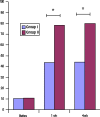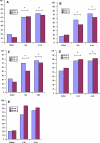Influence of religiosity on the quality of life and on pain intensity in chronic pancreatitis patients after neurolytic celiac plexus block: case-controlled study
- PMID: 21286817
- PMCID: PMC3560951
- DOI: 10.1007/s10943-011-9454-z
Influence of religiosity on the quality of life and on pain intensity in chronic pancreatitis patients after neurolytic celiac plexus block: case-controlled study
Abstract
The quality of life in patients with chronic pancreatitis (CP) is reduced due to their suffering of high levels of pain. It has been presented that quality of life can also be linked to religiosity and/or spirituality. The aim of this study is to assess the influence of religious practices on the quality of life and on the subjective level of pain in CP patients. Ninety-two patients (37 women and 55 men) with chronic pancreatitis were treated invasively for pain with neurolytic celiac plexus block (NCPB). The religiosity of the patients was recorded and served as a dichotomizer. Group 1 was for patients who claimed to have no contact with the church or to have very sporadic contact (N = 35 patients). Group 2 was for patients who claimed to have deep faith and were regular participants at church activities (N = 57 patients). Visual analogue scale was used to assess pain, while the quality of life was measured by using QLQ C-30 questionnaire adapted for chronic pancreatitis patients in Polish population. The patients were assessed prior to the pain-relieving intervention and subsequently 2 and 8 weeks after it. The intensity of pain was reduced in both groups significantly after performing the NCPB. Patients who declared a deep faith reported higher level of pain on the VAS scale prior to intervention than non-religious patients. Quality of life in both groups of patients significantly improved after NCPB. Following NCPB, global quality of life in patients who declared higher religiosity/church attendance was significantly higher (79.88) than for those patients who have no contact or sporadic contact with the church (44.21, P < 0.05). NCPB resulted in significant reduction of pain and increase in quality of life in both groups of patients with CP. Nevertheless, in the group declaring higher religiosity/church attendance, reported pain was higher, but, despite that, quality of life better. It may be concluded that religious practices might serve as an additional factor improving quality of life and coping in patients suffering from chronic pancreatitis.
Figures


References
-
- Bussing, A., Michalsen, A., Balzat, H. J., Grunther, R. A., Ostermann, T., Neugebauer, E. A. et al. (2009). Are spirituality and religiosity resources for patients with chronic pain conditions? Pain Medicine (Malden, Mass.), 10(2), 327–339. - PubMed
MeSH terms
LinkOut - more resources
Full Text Sources
Medical
Miscellaneous

